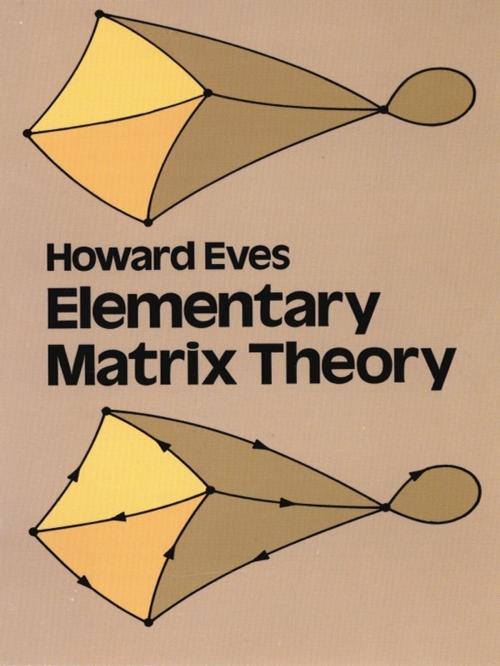| Author: | Howard Eves | ISBN: | 9780486150277 |
| Publisher: | Dover Publications | Publication: | April 30, 2012 |
| Imprint: | Dover Publications | Language: | English |
| Author: | Howard Eves |
| ISBN: | 9780486150277 |
| Publisher: | Dover Publications |
| Publication: | April 30, 2012 |
| Imprint: | Dover Publications |
| Language: | English |
The usefulness of matrix theory as a tool in disciplines ranging from quantum mechanics to psychometrics is widely recognized, and courses in matrix theory are increasingly a standard part of the undergraduate curriculum.
This outstanding text offers an unusual introduction to matrix theory at the undergraduate level. Unlike most texts dealing with the topic, which tend to remain on an abstract level, Dr. Eves' book employs a concrete elementary approach, avoiding abstraction until the final chapter. This practical method renders the text especially accessible to students of physics, engineering, business and the social sciences, as well as math majors. Although the treatment is fundamental — no previous courses in abstract algebra are required — it is also flexible: each chapter includes special material for advanced students interested in deeper study or application of the theory.
The book begins with preliminary remarks that set the stage for the author's concrete approach to matrix theory and the consideration of matrices as hypercomplex numbers. Dr. Eves then goes on to cover fundamental concepts and operations, equivalence, determinants, matrices with polynomial elements, similarity and congruence. A final optional chapter considers matrix theory from a generalized or abstract viewpoint, extending it to arbitrary number rings and fields, vector spaces and linear transformations of vector spaces. The author's concluding remarks direct the interested student to possible avenues of further study in matrix theory, while an extensive bibliography rounds out the book.
Students of matrix theory will especially appreciate the many excellent problems (solutions not provided) included in each chapter, which are not just routine calculation exercises, but involve proof and extension of the concepts and material of the text. Scientists, engineers, economists and others whose work involves this important area of mathematics, will welcome the variety of special types of matrices and determinants discussed, which make the book not only a comprehensive introduction to the field, but a valuable resource and reference work.
The usefulness of matrix theory as a tool in disciplines ranging from quantum mechanics to psychometrics is widely recognized, and courses in matrix theory are increasingly a standard part of the undergraduate curriculum.
This outstanding text offers an unusual introduction to matrix theory at the undergraduate level. Unlike most texts dealing with the topic, which tend to remain on an abstract level, Dr. Eves' book employs a concrete elementary approach, avoiding abstraction until the final chapter. This practical method renders the text especially accessible to students of physics, engineering, business and the social sciences, as well as math majors. Although the treatment is fundamental — no previous courses in abstract algebra are required — it is also flexible: each chapter includes special material for advanced students interested in deeper study or application of the theory.
The book begins with preliminary remarks that set the stage for the author's concrete approach to matrix theory and the consideration of matrices as hypercomplex numbers. Dr. Eves then goes on to cover fundamental concepts and operations, equivalence, determinants, matrices with polynomial elements, similarity and congruence. A final optional chapter considers matrix theory from a generalized or abstract viewpoint, extending it to arbitrary number rings and fields, vector spaces and linear transformations of vector spaces. The author's concluding remarks direct the interested student to possible avenues of further study in matrix theory, while an extensive bibliography rounds out the book.
Students of matrix theory will especially appreciate the many excellent problems (solutions not provided) included in each chapter, which are not just routine calculation exercises, but involve proof and extension of the concepts and material of the text. Scientists, engineers, economists and others whose work involves this important area of mathematics, will welcome the variety of special types of matrices and determinants discussed, which make the book not only a comprehensive introduction to the field, but a valuable resource and reference work.















